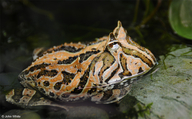|
Ceratophrys ornata (Bell, 1843)
Bell's Horned Frog, Escuerzo | family: Ceratophryidae genus: Ceratophrys |
 © 2010 John White (1 of 7) |
|
|
|
Description For Uruguayan specimens, the dorsal color is dark green with brown red, and yellow spots, and a V-shaped marking is present between the eyes (Achaval and Olmos 2003). Color may also be brown (Bartlett and Bartlett 2000). The edges of the mouth are yellow (Achaval and Olmos 2003). In the male the gular area appears mottled (Achaval and Olmos 2003). The venter is quite granular in Ceratophrys ornata from Tigre, Buenos Aires, Argentina (Canziani and Cannata 1979). Distribution and Habitat Country distribution from AmphibiaWeb's database: Argentina, Brazil, Uruguay
Life History, Abundance, Activity, and Special Behaviors Frogs of the genus Ceratophrys are sit-and-wait predators, partially concealing themselves in the leaves of the forest floor and remaining motionless most of the time (Duellman and Lizana 1994). When prey approaches, the animal quickly attacks, usually swallowing the prey whole (Duellman and Lizana 1994). Ceratophrys ornata consumes primarily vertebrates; stomach content analysis of thirty-four specimens from Uruguay included 78.5% anurans, 11.7% passerine birds, 7.7% rodents, and 0.3% snakes, leaving only 1.8% as "other" (Basso 1990). It burrows during autumn and winter (Canziani and Cannata 1979). While buried, it creates a cocoon around itself to protect from water loss (Canziani and Cannata 1979). It emerges to breed in the late spring, when enough rain has fallen to create temporary pools (Canziani and Cannata 1979). Eggs are laid on the bottom of these temporary ponds (Stuart et al. 2008). Larva Trends and Threats Relation to Humans Possible reasons for amphibian decline General habitat alteration and loss Comments This species was first described by Günther (1859). It has been reported that C. ornata are octoploid (Schmid et al. 1985); individuals analyzed were collected in Argentina but the locality was not given, raising the possibility that the specimens might have been C. cranwelli. Records referred to as C. ornata from the Chacoan region of Argentina (cf. the South Chaco specimens of Canziani and Cannata 1979) are actually Ceratophrys cranwelli (Cei 1987), as are records from Paraguay (Brusquetti and Lavilla 2006).
References
Bartlett, R. D., and Bartlett, P. (2000). The horned frog family and African bullfrogs. Barron's Educational Series, Inc., New York. Basso, N. G. (1990). ''Estrategias adaptivas en una comunidad subtropical de anuros.'' Cuadernos de Herpetologia Serie Monografías, 1, 1-70. Braun, P. C. and Braun, C. A. S. (1980). ''Lista prévia dos anfíbios do Estado do Rio Grande do Sul, Brasil.'' Iheringia, 56, 121-146. Brusquetti, F., and Lavilla, E.O. (2006). ''Lista comentada de los anfibios de Paraguay.'' Cuadernos de Herpetologica, 20, 3-79. Canziani, G. A., and Cannata, M. A. (1980). ''Water balance in Ceratophrys ornata from two different environments.'' Comparative Biochemistry and Physiology , 66A, 599-603. Cei, J. M. (1980). ''Amphibians of Argentina.'' Monitore Zoologica Italiano, New Series Monografia, Firenze, 2, 1-609. Cei, J. M. (1987). ''Additional notes to ''Amphibians of Argentina'': an update, 1980-1986.'' Monitore Zoologico Italiano. Nuova Serie, Supplemento. Firenze, 21, 209-272. Cochran, D. M. (1955). ''Frogs of southeastern Brazil.'' Bulletin of the U.S. National Museum, 206, 1-423. Duellman, W.E., and Lizana, M. (1994). ''Biology of a sit-and-wait predator, the leptodactylid frog Ceratophrys cornuta.'' Herpetologica, 50, 51-64. Gambarotta, J. C., Saralegui, A. and Gonzalez, E. M. (1999). ''Vertebrados tetrapodos del Refugio de Fauna Laguna de Castillos, Departamento de Rocha.'' Relavamientos de Biodiversidad, 3, 1-31. Günther, A. (1859). Catalogue of the Batrachia Salientia in the collection of the British Museum. Taylor and Francis, London. Hornegger, R. E., Schneider, C., and Zimmerman, E. (1985). ''Notizen zur Aufzucht von Schmuckhornfroeschen.'' Salamandra, 21(1), 70-80. Lavilla, E. O., and Cei, J. M. (2001). Amphibians of Argentina, A Second Update, 1987-2000. Museo Regionale di Scienze Naturali, Torino. Maneyro, R., and Langone, J. A. (2001). ''Categorización de los anfibios del Uruguay.'' Cuadernos de Herpetología, 15(2), 107-118. Natale, G. S., Alcalde, L., Herrera, R., Cajade, R., Schaefer, E. F., Marangoni, F., and Trudeau, V. L. (2010). ''Underwater acoustic communication in the macrophagic carnivorous larvae of Ceratophrys ornata (Anura: Ceratophryidae).'' Acta Zoologica, published online before print, February 26, 2010, (doi: 10.1111/j.1463-). Schmid, M., Haaf, T., and Schempp, W. (1985). ''Chromosome banding in Amphibia. IX. The polyploid karyotypes of Odontophrynus americanus and Ceratophrys ornata (Anura, Leptodactylidae).'' Chromosoma, 91, 172-184. Originally submitted by: Franziska Sandmeier (first posted 2001-03-12) Edited by: Kellie Whittaker, Michelle S. Koo (2024-07-21) Species Account Citation: AmphibiaWeb 2024 Ceratophrys ornata: Bell's Horned Frog <https://amphibiaweb.org/species/5723> University of California, Berkeley, CA, USA. Accessed May 27, 2025.
Feedback or comments about this page.
Citation: AmphibiaWeb. 2025. <https://amphibiaweb.org> University of California, Berkeley, CA, USA. Accessed 27 May 2025. AmphibiaWeb's policy on data use. |




 Map of Life
Map of Life